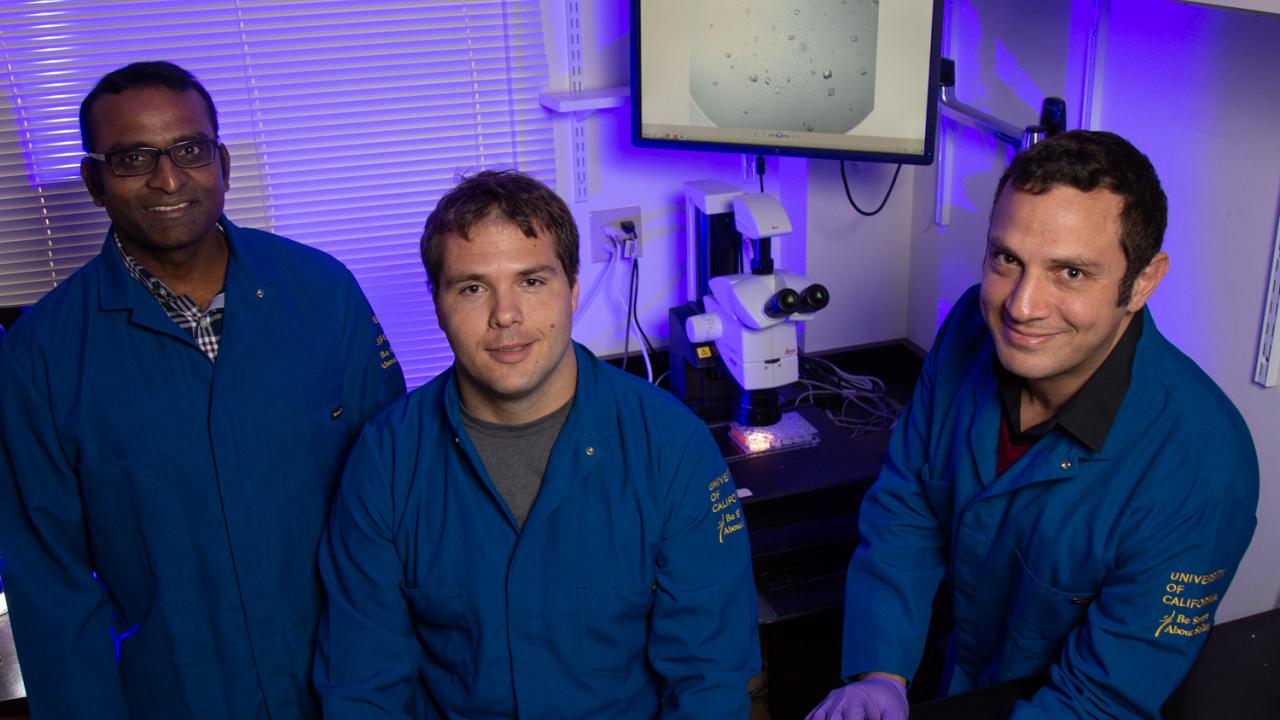
Visualizing “Unfurling” Microtubule Growth
Quick Summary
- When cells divide, microtubule fibers pull the chromosomes apart into new cells
- In a new animation, UC Davis researchers visualize how microtubule fibers organize
- A paper describing the work appeared in the journal eLife
Living cells depend absolutely on tubulin, a protein that forms hollow tube-like polymers, called microtubules, that form scaffolding for moving materials inside the cell. Tubulin-based microtubule scaffolding allows cells to move, keeps things in place or moves them around. When cells divide, microtubule fibers pull the chromosomes apart into new cells. Cells with defects in tubulin polymerization die.
Microtubule fibers are hollow rods made of much smaller tubulin subunits that spontaneously assemble at one end of the rod, but exactly how they do this inside the crowded environment of living cells has been a mystery. Now researchers at UC Davis have uncovered the mechanism that puts these blocks in place, illustrated in a new animation.
“It’s going to transform how people think about microtubule polymerization,” said Jawdat Al-Bassam, associate professor of molecular and cellular biology in the UC Davis College of Biological Sciences. A paper describing the work appears Nov. 13 in the journal eLife.
The work describes snapshots of a set of domains called TOGs, or Tumor Overexpressed Genes, caught in the act of driving tubulin polymerization. As the name suggests, TOGs are abundant in rapidly-dividing cancer cells. They show a similar structure in organisms from yeast to people.
Working in yeast, project scientist Stanley Nithianantham, Al-Bassam and colleagues showed how a protein called Alp14, with four TOG domains, speeds up tubulin polymerization into microtubules by carrying four tubulin units to the correct end of a microtubule and neatly unloads them in the right order to build out the end.
Alp14 represents a group of well-preserved proteins that are essential for cellular homeostasis and division of cells found from a yeast to human cell. It consists of an assembly linked flexible linker with two TOG1 and two TOG2 domains. Add four tubulin units (two per TOG domain) and it forms a circle with the TOGs facing each other and tubulins on the outside.
When the TOG/tubulin circles reach the growing end of a microtubule, TOG1 docks its tubulin with the growing end, destabilizing the circle so that it unfurls, placing four tubulins in order on the end. The name was chosen because the process is like unfurling a folded sail on boat in the wind.
“It’s a complete surprise that it’s such an ordered, concerted process,” Al-Bassam said.
As tubulins units are added to the microtubule strand, they straighten out, driving further disassociation of tubulins from TOGs. The process explains how multiple TOGs speed up tubulin assembly for the first time.
The researchers are following this work with studies of mutant proteins of Alp14 designed with predicted defects in this process to test this suggested mechanism using imaging approaches of dynamic tubulin assembly in and outside living cells. The researchers plan to follow up with further studies of the process, including using cryoelectron microscopy that allows them to visualize single protein molecules in their natural state.
Additional authors on the paper are Brian Cook, Madeleine Beans and Fei Guo at UC Davis and Fred Chang at UC San Francisco. The animation was produced by Julian Eskin of Brandeis University. The work was supported by grants from the NIH and made use of the Advanced Photon Source, a facility operated by the Argonne National Laboratory on behalf of the U.S. Department of Energy Office of Science.

Media Resources
- Read the paper in eLife
- This story first appeared on the UC Davis Egghead blog
